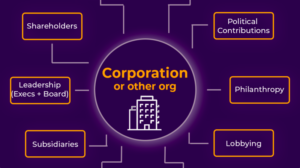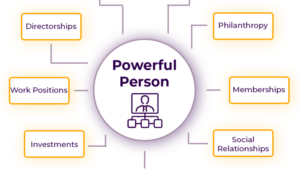2. Investors & Creditors

What to look for: If you are investigating a corporation, who are its investors? Who are its creditors?
Investors
Where to find it: The SEC’s EDGAR database, Yahoo! Finance, Whale Wisdom, Google.
For public companies, there are several different ways to identify investors. EDGAR provides us with some of this information (see section 1 for more detailed instructions on accessing EDGAR). A public company’s DEF 14A lists any individual or institutional investor that owns 5% or more of the company’s shares. It also includes the number of shares controlled by each director and each member of top management. Sometimes, public companies have credit agreements with banks that they list in their 10-K report. To find this, check the exhibits to the 10-K (usually towards the end of the filing). The company might list their credit agreement there.
A credit agreement might also appear in a company’s 8-K’s with Exhibit 10.1 attached to it. Here’s an example from the oil and gas company Energy Transfer Partners.
Yahoo! Finance aggregates stock ownership info as well. To find it, go to a company’s Yahoo! Finance profile and click the “Holders” tab. See the private prison company GEO’s holders tab here as an example.
Institutional investment managers such as hedge funds also have to file a form called a eF with the SEC that discloses their investment holdings quarterly. The site Whalewisdom.com lets you easily search these filings by investment manager or company.
You can also use EDGAR to search for a company’s 13-D or 13-G forms, which disclose when a party purchases more than 5% of a company’s stock.
Power Research in Action
In 2016, a powerful, indigenous people-led movement began to stop the massive Dakota Access oil pipeline from being built. Power Researchers identified which corporations and banks were behind the pipeline, including Wells Fargo, Credit Suisse, and Citibank. Equipped with this information, indigenous activists and their allies called on these banks to stop funding the pipeline. They brought the #NODAPL fight to cities around the world, protesting at bank headquarters, pressuring cities to divest from the banks, and raising concerns with shareholders, ultimately succeeding in getting several banks to commit to pulling their funding for the project.
Creditors
Where to find it: The SEC’s EDGAR database.
Publicly traded corporations are reliant on loans and lines of credit from large banks to finance their operations. These credit transactions are reported in periodic filings with the Securities and Exchange Commission (SEC) which can be found in the EDGAR database. Sometimes, these credit agreements are included in a company’s 10-K filing (in the “Exhibit” sections), and sometimes they are filed as 8-Ks, usually with an exhibit starting with 10.1. You can use the “search in text documents” tool in EDGAR and search for “credit agreement” for a quicker way to look for these agreements.








